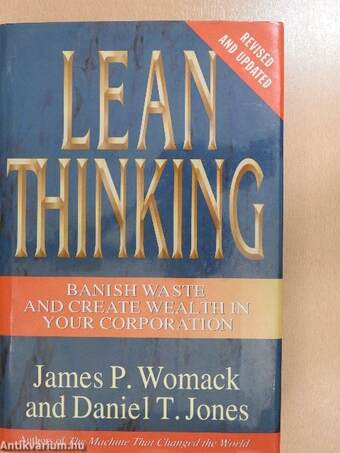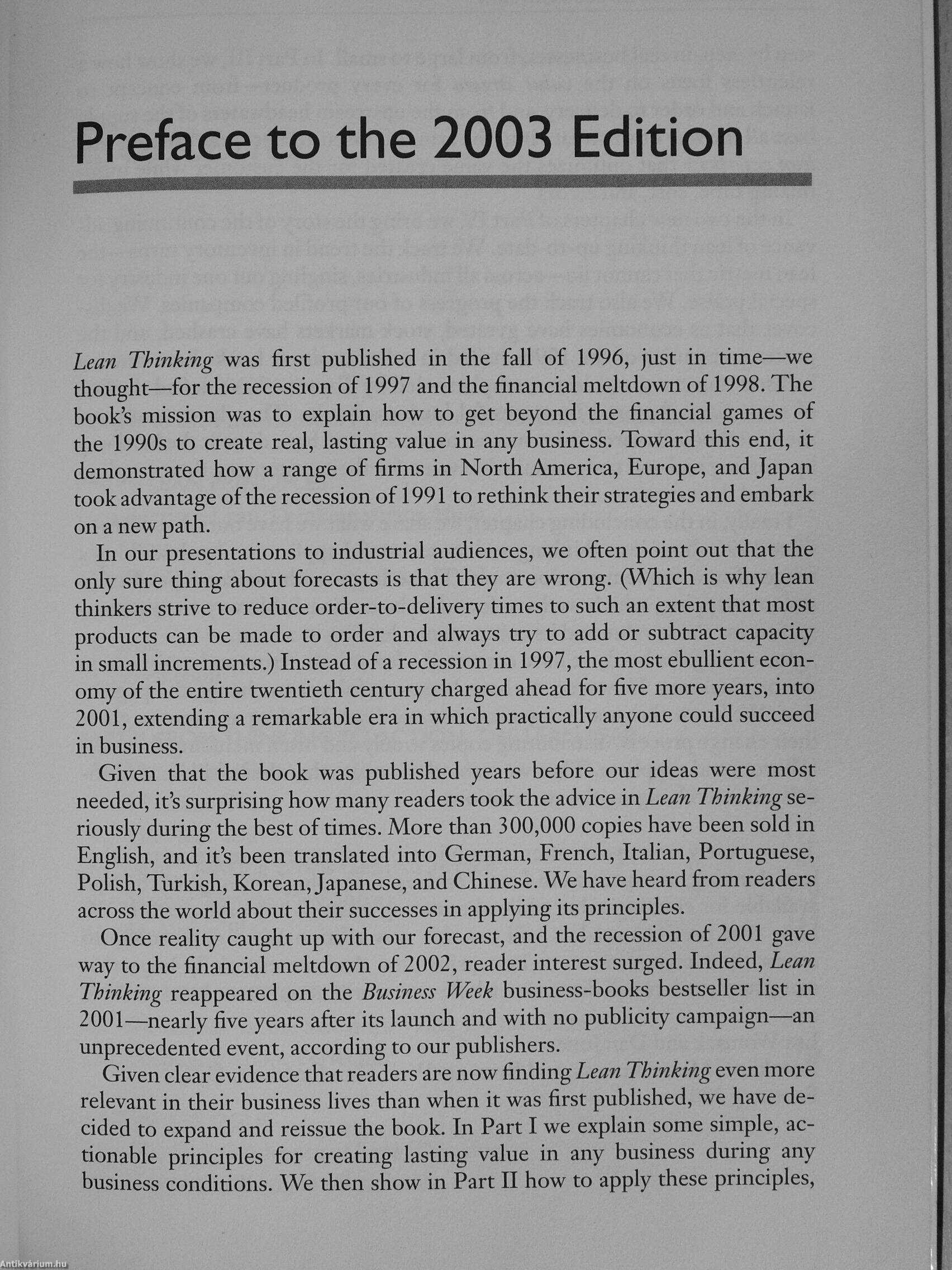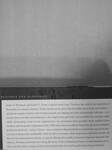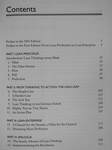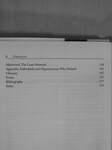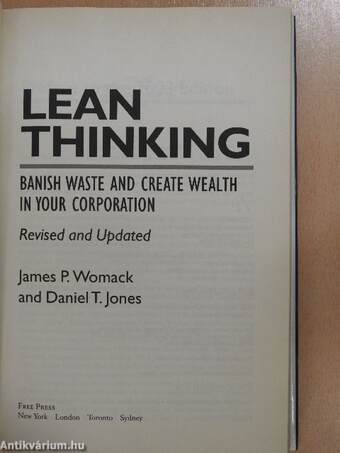1.103.822
kiadvánnyal nyújtjuk Magyarország legnagyobb antikvár könyv-kínálatát

VISSZA
A TETEJÉRE
JAVASLATOKÉszre-
vételek
Lean Thinking
Banish Waste and Create Wealth in Your Corporation/Revised and Updated
| Kiadó: | Free Press |
|---|---|
| Kiadás helye: | New York-London |
| Kiadás éve: | |
| Kötés típusa: | Ragasztott kemény papírkötés |
| Oldalszám: | 396 oldal |
| Sorozatcím: | |
| Kötetszám: | |
| Nyelv: | Angol |
| Méret: | 24 cm x 16 cm |
| ISBN: | 0-7432-4927-5 |
| Megjegyzés: | Fekete-fehér ábrákkal illusztrálva. |
naponta értesítjük a beérkező friss
kiadványokról
naponta értesítjük a beérkező friss
kiadványokról
Előszó
TovábbFülszöveg
business and economics
James P. Womack and Daniel T. Jones's classic book Lean Thinking has sold in the hundreds of thousands in a dozen countries. Today, nearly seven years after the publication of the first edition— and given ample evidence that businesspeople are finding the book increasingly relevant—it is clearer than ever that lean thinking is the single most powerful tool available for creating value while eliminating waste in any organization. As economies have gyrated, stock markets have crashed, and the poster companies of the 1990s have flown a ballistic trajectory, the lean exemplars profiled in the book—led by Toyota—have continued their methodical march from success to success by creating truly sustainable value for their customers, their employees, and their owners. In this revised and updated edition, on top of offering the wealth of practical material from the first edition, Womack and Jones now bring the story of the continuing advance of lean thinking... Tovább
Fülszöveg
business and economics
James P. Womack and Daniel T. Jones's classic book Lean Thinking has sold in the hundreds of thousands in a dozen countries. Today, nearly seven years after the publication of the first edition— and given ample evidence that businesspeople are finding the book increasingly relevant—it is clearer than ever that lean thinking is the single most powerful tool available for creating value while eliminating waste in any organization. As economies have gyrated, stock markets have crashed, and the poster companies of the 1990s have flown a ballistic trajectory, the lean exemplars profiled in the book—led by Toyota—have continued their methodical march from success to success by creating truly sustainable value for their customers, their employees, and their owners. In this revised and updated edition, on top of offering the wealth of practical material from the first edition, Womack and Jones now bring the story of the continuing advance of lean thinking up-to-date, and also share a range of new tools aimed at the successful application of lean thinking.
Expanded, updated, and more relevant than ever, this bestselling business classic by two internationally renowned management analysts describes a business system for the twenty-first century that supersedes the mass production system of Ford, the financial control system of Sloan, and the strategic system of Welch and GE. It is based on the Toyota (lean) model, which combines operational excellence with value-based strategies to produce steady growth through a wide range of economic conditions.
In contrast with the crash-and-burn performance of companies trumpeted by business gurus in the 1990s, the firms profiled in Lean Thinking—from tiny Lantech to midsized Wiremoid to niche producer Porsche to gigantic Pratt & Whitney—have kept on keeping on, largely unnoticed, along a steady upward path through the market turbulence and crushed dreams of the early twenty-first century. Meanwhile, the leader in lean thinking—Toyota—has set its sights on leadership of the global motor vehicle industry in this decade.
Instead of constantly reinventing business models, lean thinkers go back to basics by asking what the customer really perceives as value. (It's often not at all what existing organizations and assets would suggest.) The next step is to line up value-creating activities for a specific product along a value stream while eliminating activities (usually the majority) that don't add value. Then the lean thinker creates a flow condition in which the design and the product advance smoothly and rapidly at the pull of the customer (rather than the push of the producer). Finally, as flow and pull are implemented, the lean thinker speeds up the cycle of improvement in pursuit of perfection. The first part of this book describes each of these concepts and makes them come alive with striking examples.
Lean Thinking cleariy demonstrates that these simple ideas can breathe new hfe into any company in any industry in any country. But most managers need guidance on how to make the lean leap in their firm. Part II provides a step-by-step action plan, based on in-depth studies of more than fifty lean companies in a wide range of industries across the world.
(continued on back flap) ^
(continued from front flap)
Even those readers who beUeve they have embraced lean thinking will discover in Part III that another dramatic leap is possible by creating an extended lean enterprise for each of their product families that tightly links value-creating activities from raw materials to customer.
In Part IV, an epilogue to the original edition, the story of lean thinking is brought up-to-date with an enhanced action plan based on the experiences of a range of lean firms since the original publication of Lean Thinking.
Lean Thinking does not provide a new management "program" for the one-minute manager. Instead, it offers a new method of thinking, of being, and, above all, of doing for the serious long-term manager—a method that is changing the world. Vissza
Témakörök
- Közgazdaságtan > Menedzserképzés, marketing
- Közgazdaságtan > Gazdaságpolitika
- Közgazdaságtan > Számvitel, elemzés
- Közgazdaságtan > Gazdaságátalakítás > Szerkezetváltás
- Idegennyelv > Idegennyelvű könyvek > Angol > Közgazdaságtan > Menedzserképzés, marketing
- Idegennyelv > Idegennyelvű könyvek > Angol > Közgazdaságtan > Gazdaságpolitika
- Idegennyelv > Idegennyelvű könyvek > Angol > Közgazdaságtan > Számvitel, elemzés
- Idegennyelv > Idegennyelvű könyvek > Angol > Közgazdaságtan > Gazdaságátalakítás > Szerkezetváltás
- Közgazdaságtan > Vállalkozások > Általában
- Idegennyelv > Idegennyelvű könyvek > Angol > Közgazdaságtan > Vállalkozások > Általában
Megvásárolható példányok
Nincs megvásárolható példány
A könyv összes megrendelhető példánya elfogyott. Ha kívánja, előjegyezheti a könyvet, és amint a könyv egy újabb példánya elérhető lesz, értesítjük.



